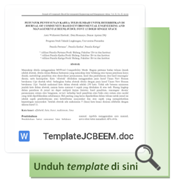PLANNING OF DOMESTIC WASTEWATER FACILITIES (CASE STUDY: BABAKAN VILLAGE, CIPARAY DISTRICT, BANDUNG REGENCY)
DOI:
https://doi.org/10.23969/jcbeem.v5i2.3895Keywords:
Wastewater Access, Communal WWTP, Risk Weighting, Scorring, Priority AreaAbstract
Babakan Village has a problem that there is still a lack of facilities for wastewater. This condition can be seen from the access to the toilets of 2436 households; only around 1506 families have access to family/ shared latrines and 625 households that meet technical requirements. For this reason, this plan is useful for increasing access and meeting community needs for domestic wastewater treatment facilities in the study area. This planning stage begins with a survey and sanitation inspection to determine 3 priority areas for handling. Determinants of this priority area use the method of scoring and weighting the risk. The weighting results put sub village 02 with a score of 2.3, sub village 05 with a score of 2.25, and RW 10 with a risk value of 2 as the priority area for planning handlers. Primary data collected will be used as a consideration for determining the technology to be applied. The technology chosen for processing is the communal septic tank for people who do not have treatment. In contrast, for the washing bath, toilet with a biofilter unit for people who do not have wastewater infrastructure.
Downloads
References
Anonymous. (2018). Data Demografi penduduk Desa Babakan. Kantor desa babakan : Ciparay- Kab.Bandung
Ariola, M. M. (2006). Principles and Methods of Research (1st ed.). Rex Printing Company, Inc.: Queson, Philippines
Bartram, J, & Cairncross, S. (2010). Hygene, Sanitation, and Water: Forgotten Fondations of Health. Plos Medicine, 7(11): e1000367.
Buku Putih Sanitasi 2016 : Area Beresiko Sanitasi http://sippa.ciptakarya.pu.go.id/sippa_onlin e/ws_file/dokumen_usulan/ssk/SSK_18-07- 2014.pdf
Hardjosuprapto, M. M. (2000). Penyaluran Air Buangan (PAB) (Vol. Volume II). Bandung: Institut Teknologi Bandung.
Hasbiah, A.W., Rusmaya, D., Apriani, D. (2019) Sanitasi Berbasis Masyarakat di Pesantren Putri Al-Ittihad, Kabupaten Cianjur. Journal of Community Based Environmental Engineering and Management, 3(1): 1-8.
Mulyatna, L., Wahyuni, S., Wilantri, R.S., Yustiani, Y.M. (2021) Evaluation on the sanitation facilities in the Gegerkalong Traditional Market, Bandung, Indonesia. IOP Conference Series: Earth and Environmental Science, 737(1): 012072
Prameswari, RA. & Purnomo, A. (2014) Perencanaan Pelayanan Air Limbah Komunal di Desa Krasak Kecamatan Jatibarang Kota Indramayu. Jurnal Teknik POMITS, 3(2): 81-84
PerMen PUPR. (2017). Peraturan Menteri Pekerjaan Umum dan Perumahan Rakyat No. 04/PRT/2017 Tentang Penyelenggaraan Sistem Pengelolaan Air Limbah Domestik.
Rusmaya, D., Rochaeni, A., Dewi, N.P. (2019) Penentuan Fasilitas Sanitasi Berdasarkan Persepsi Santri di Tahfids Qur’an Madrasah Tsanawiyah (MTS) Assalaam, Kota Bandung. Journal of Community Based Environmental Engineering and Management, 3(1): 15-24.
Setiawati, R.T. (2017). Perencanaan Instalasi Pengolahan Air Limbah Domestik di Kecamatan Simokerto. IPTEK Journal of Proceedings Series, 5.
Yustiani, Y.M., Rochaeni, A., Aulia, E. (2019). Konsep Pengelolaan Sampah di Desa Babakan Kabupaten Bandung. EnviroScienteae, 15(1): 121-126.














